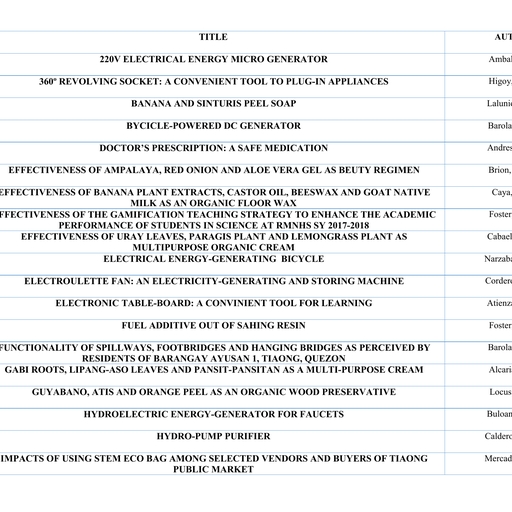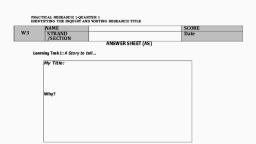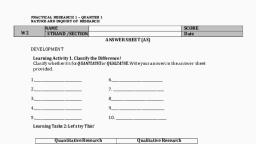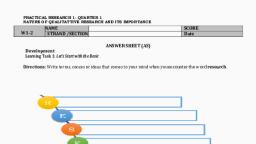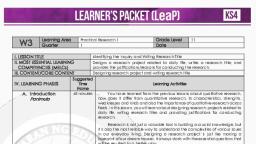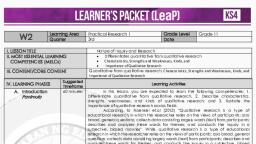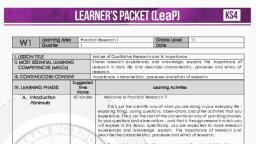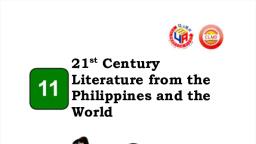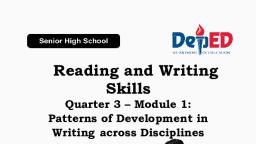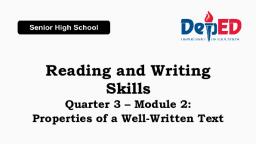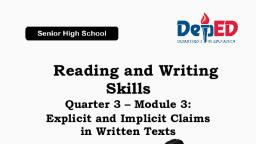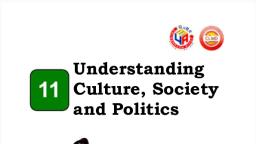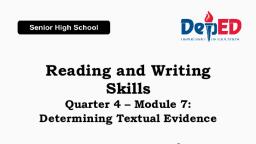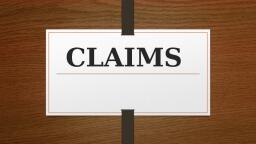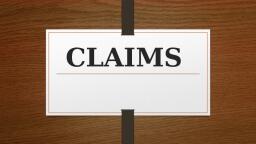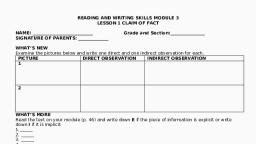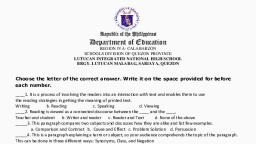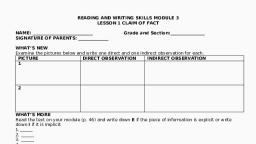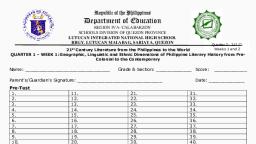Page 1 :
Reading and Writing, Skills, Quarter 3 – Module 3:, Explicit and Implicit Claims, in Written Texts
Page 2 : Reading and Writing Skills, Alternative Delivery Mode, Quarter 3 – Module 3: Explicit and Implicit Claims in Written Text, First Edition, 2020, Republic Act 8293, section 176 states that: No copyright shall subsist in any work of, the Government of the Philippines. However, prior approval of the government agency or office, wherein the work is created shall be necessary for exploitation of such work for profit. Such, agency or office may, among other things, impose as a condition the payment of royalties., Borrowed materials (i.e., songs, stories, poems, pictures, photos, brand names,, trademarks, etc.) included in this module are owned by their respective copyright holders., Every effort has been exerted to locate and seek permission to use these materials from their, respective copyright owners. The publisher and authors do not represent nor claim ownership, over them., Published by the Department of Education, Secretary: Leonor Magtolis Briones, Undersecretary: Diosdado M. San Antonio, Development Team of the Module, Writers: Kristine Y. Zantua, Jayson B. Agarin, Editors: Shiela Niña L. Rea-Santes, Orven Francis G. De Pedro, Reviewers: Cyril E. Sales, Susana J. Sacatrapos, Louie Grace G. Margallo, Laila R., Maloles, Jonathan H. Marquez, Jhonathan S. Cadavido, Illustrator: Jayson K. Latade, Layout Artists: Victoria P. Gabiano, Mark Joseph O. Torres, Management Team: Regional Director: Wilfredo E. Cabral, CLMD Chief: Job S. Zape Jr., Regional EPS In Charge of LRMS: Eugenio S. Adrao, Regional ADM Coordinator: Elaine T. Balaogan,, Schools Division Superintendents: Ludy N. Pasagui,, Doris DJ. Estalilla, Assistant School Division Superintendent/s: Neil G. Angeles,, Elvira B. Catangay, CID Chief/s: Vincent Emmanuel L. Ilagan, Edna F. Hemedez, Division EPS/s In Charge of LRMS: Henry P. Contemplacion,, Jackie Lou A. Almira, Printed in the Philippines by ________________________, Department of Education – RegionIV-A CALABARZON, Office Address:, Telefax:, E-mail Address:, , Gate 2 Karangalan Village, Barangay San Isidro, Cainta, Rizal 1800, 02-8682-5773/8684-4914/8647-7487,
[email protected], i
Page 3 :
Reading and Writing, Skills, Quarter 3 – Module 3:, Explicit and Implicit Claims, in Written Texts, , 1
Page 4 :
Introductory Message, For the facilitator:, Welcome to the Reading and Writing Skills Alternative Delivery Mode (ADM) Module, on the Explicit and Implicit Claims in Written Texts., This module was collaboratively designed, developed and reviewed by educators both, from public and private institutions to assist you, the teacher or facilitator in helping, the learners meet the standards set by the K to 12 Curriculum while overcoming, their personal, social, and economic constraints in schooling., This learning resource hopes to engage the learners into guided and independent, learning activities at their own pace and time. Furthermore, this also aims to help, learners acquire the needed 21st century skills while taking into consideration their, needs and circumstances., In addition to the material in the main text, you will also see this box in the body of, the module:, , Notes to the Teacher, This contains helpful tips or strategies that will help you in guiding the learners., As a facilitator, you are expected to orient the learners on how to use this module., You also need to keep track of the learners' progress while allowing them to manage, their own learning. Furthermore, you are expected to encourage and assist the, learners as they do the tasks included in the module., , For the learner:, Welcome to the Reading and Writing Skills Alternative Delivery Mode (ADM) Module, on the Explicit and Implicit Claims in Written Texts!, The hand is one of the most symbolized parts of the human body. It is often used to, depict skill, action and purpose. Through our hands, we may learn, create and, accomplish. Hence, the hand in this learning resource signifies that you as a learner, is capable and empowered to successfully achieve the relevant competencies and, skills at your own pace and time. Your academic success lies in your own hands!, This module was designed to provide you with fun and meaningful opportunities for, guided and independent learning at your own pace and time. You will be enabled to, process the contents of the learning resource while being an active learner., , 2
Page 5 :
This module has the following parts and corresponding icons:, What I Need to Know, , This will give you an idea of the skills or, competencies you are expected to learn in the, module., , What I Know, , This part includes an activity that aims to, check what you already know about the, lesson to take. If you get all the answers, correct (100%), you may decide to skip this, module., , What’s In, , This is a brief drill or review to help you link, the current lesson with the previous one., , What’s New, , In this portion, the new lesson will be, introduced to you in various ways such as a, story, a song, a poem, a problem opener, an, activity or a situation., , What is It, , This section provides a brief discussion of the, lesson. This aims to help you discover and, understand new concepts and skills., , What’s More, , This comprises activities for independent, practice to solidify your understanding and, skills of the topic. You may check the, answers to the exercises using the Answer, Key at the end of the module., , What I Have Learned, , This, includes, questions, or, blank, sentence/paragraph to be filled-in to process, what you learned from the lesson., , What I Can Do, , This section provides an activity which will, help you transfer your new knowledge or skill, into real life situations or concerns., , Assessment, , This is a task which aims to evaluate your, level of mastery in achieving the learning, competency., , Additional Activities, , In this portion, another activity will be given, to you to enrich your knowledge or skill of the, lesson learned. This also tends retention of, learned concepts., , Answer Key, , This contains answers to all activities in the, module., , 3
Page 6 :
At the end of this module you will also find:, , References, , This is a list of all sources used in developing, this module., , The following are some reminders in using this module:, 1. Use the module with care. Do not put unnecessary mark/s on any part of the, module. Use a separate sheet of paper in answering the exercises., 2. Don’t forget to answer What I Know before moving on to the other activities, included in the module., 3. Read the instruction carefully before doing each task., 4. Observe honesty and integrity in doing the tasks and checking your answers., 5. Finish the task at hand before proceeding to the next., 6. Return this module to your teacher/facilitator once you are through with it., If you encounter any difficulty in answering the tasks in this module, do not hesitate, to consult your teacher or facilitator. Always bear in mind that you are not alone., We hope that through this material, you will experience meaningful learning and, gain deep understanding of the relevant competencies. You can do it!, , What I Need to Know, Reading engagement becomes very productive when learners like you have to be, conscious in giving sound reactions about the text. This is a manifestation that your, attachment towards the reading materials becomes intense. Consequently, you are, reaching the stage where critical reading happens. As critical readers, you can assess, texts that exhibit specific claims such as claim of fact, claim of value, and claim of, policy., This module is divided into a variety of activities which you will answer at your own, pace so that you will be able to learn the skills that will enable you to read critically, and react logically., The module is divided into three lessons, namely:, , , , , Lesson 1 – Claim of Fact, Lesson 2 – Claim of Policy, Lesson 3 – Claim of Value, , 4
Page 7 :
After going through this module, you are expected to:, 1. identify claims explicitly or implicitly made in a written text;, 2. determine the key elements of explicit and implicit claims;, 3. differentiate claim of fact, claim of policy and claim of value from each other;, and, 4. identify claims of fact, policy and value presented in written texts., , What I Know, Write the letter of the best answer on a separate sheet., 1. Which of the following statements is an example of a claim?, a. Ruiz believes that change has come., b. Filipinos need to exercise their right to vote., c. Annie thinks that we should have a universal health care., d. All of the above, 2. The following are characteristics of a good claim EXCEPT, a. argumentative and debatable, b. specific and focused, c. interesting and engaging, d. fun and entertaining, 3. Jeremiah is happy because he gets good grades. Which question from the, list below is explicit?, a. Who is Jeremiah?, b. Where is Jeremiah?, c. What did Jeremiah feel after seeing his grades?, d. What did Jeremiah do to be able to get a good grade?, 4. What specific claim asserts some empirical (experience/ observation-based), truth?, a. claim of fact, b. claim of value, c. claim of policy, d. claim of judgment, 5. Tears came out of Rhianne’s eyes when her teacher announced the, honor students. Which question relative to the given scenario is implicit?, a. What was announced?, b. Who announced the honor students?, c. What was the name of the girl who cried?, d. Why did Rhianne cry?, 5
Page 8 :
6. Coronavirus is, a. claim of, b. claim of, c. claim of, d. claim of, , now classified as a pandemic. What type of claim is this?, judgment, policy, value, fact, , 7. All characteristics are true about claim of fact EXCEPT, a. Something that can be proven or disproven with facts, b. Argues about the definition of something, c. Argues for or against a solution or policy, d. Argues whether something is a settled fact, 8. Which of the following types of claim leads to action?, a. claim of judgment, b. claim of policy, c. claim of value, d. claim of fact, 9. Which of the following question is intended for claim of policy?, a. What action can be taken?, b. Is it right or wrong?, c. Is it true or untrue?, d. Is it a yes or no?, 10. Which among the claims is claim of policy?, a. Severe acute respiratory syndrome coronavirus 2 is the reason behind, the existence of a respiratory ailment called coronavirus disease 2019, (COVID-19)., b. With what is happening in the world now, we should spend more on, research., c. Coronavirus disease is now considered to be a pandemic., d. Coronavirus disease was first discovered in China., 11. In claim of policy, which modal verb should not be used?, a. have to, b. should, c. must, d. could, 12. Giving vaccines to children without sufficient scientific studies is wrong., What specific claim is the given statement?, a. claim of value, b. claim of policy, c. claim of cause, d. claim of fact, , 6
Page 9 :
13. This question is intended for claim of value., a. What action can be taken?, b. Is it right or wrong?, c. Is it true or untrue?, d. Is it a yes or no?, 14. Which is not the reference of claim of value?, a. philosophy, b. fiction, c. ethics, d. belief, 15. Which among the claims is a claim of value?, a. Marijuana pertains to major parts taken from the Cannabis sativa or, Cannabis indica plant such as seeds, dried leaves, flowers, stems,, and seeds., b. Marijuana has adverse effect if it will be used for recreational purposes., c. Marijuana should be legalized for medical purposes., d. Marijuana can be used to treat insomnia., , Lesson, , 1, , Claim of Fact, , As a critical reader, you may encounter texts that exhibit specific claims. Some can, be directly stated while others can be mentioned indirectly. It is important to know, how you can identify them and how you can distinguish the type of claims a written, text has. These are the key concepts and skills you have to learn in this lesson., , What’s In, After learning about the properties of a well-written text, analyzing the stand or, argument of a text would be your next step. Here, you are encouraged to illustrate a, good level of understanding of the written text through verification, affirmation, and, assertion. This undertaking leads to bits of information covering a discourse called, claims., , 7
Page 10 :
What’s New, Examine the pictures below and write one direct and one indirect observation for, each., Direct Observation, , Indirect Observation, , Claims are synonymous to belief, argument, assertion, or stand. According to, (Tiongson 2016, 20-21), a good claim should be argumentative and debatable,, specific and focused, interesting and engaging, and logical., These information can be explicit or implicit. An explicit claim is directly and clearly, stated in the text. It is when you can easily point out the information in the passage., Meanwhile, an implicit claim is indirectly expressed in the text and you need to look, for cluesor make inferences to understand its meaning., There are three types of claims in written texts. One of which is the claim of fact., Simply, this claim is a statement that reports, describes predicts, make causal, claims, or whether something is a settled fact., , What’s More, A. Read the text and write down E if the piece of information is explicit or write, down I if it is implicit., “Congratulations, Rosie! Your parents must be proud of you.” The teacher greeted, her with delight. It was graduation day and Rosie managed to stand on stage and, delivered her speech in front of her fellow graduates and guests. She ended her speech, thanking her Alma mater and her parents and said, “Let us trust God’s plan.”, Rosie left the stage with tears in her eyes as the clicking of the medals could be, heard from afar., As she approached her parents, they kissed her and gave her a big hug and, uttered, “We love you, dear! Your success is our success. We will surely celebrate at, home., 8
Page 11 :
1., 2., 3., 4., 5., , The teacher congratulated Rosie., Rosie stood on stage and delivered her speech., Rosie was full of happiness., Rosie was a hard-working and intelligent student., The parents of Rosie promised to celebrate her success., , B. Put a check mark () if the statement is a claim of fact and put a cross mark (X), if it is not., 1. The Department of Education shows its readiness on the ‘new normal’ in the, teaching and learning process., 2. Curfew must be enforced by parents to their children., 3. Vaping can have same side effects as smoking., 4. The closing of Philippine borders to tourists is one way to slow down the, spread of COVID-19., 5. Doing videos in TikTok is more exciting than vlogging., 6. Research says that people can reduce stress by taking a nap., 7. It is more beneficial for a child to grow up speaking more than one, language than knowing only his or her mother tongue., 8. National ID system should now be implemented in the Philippines., 9. Neil Armstrong made a history as the first man to walk on the moon., 10. Watching K-Drama is the best form of entertainment., , What I Have Learned, On a separate sheet, copy and complete the table below by listing the needed, information., 3, THREE new things that you have learned today., 2, 1, , TWO things that you will work on for improvement., ONE thing that you should review before moving on to the next lesson., , What I Can Do, On a separate sheet of paper, write a 150-word paragraph on a topic about, “Social Media: Benefits and Drawbacks”. In this essay, you are REQUIRED to use, claims such as claim of factwhich you learned from the lesson. INDICATE the, claim(s)you used and write it at the bottommost part of your paper.You are free to, encode and print it on a bond paper. A rubric is attached for your reference on, checking the essay. The highest point that you can get for each criterion is five, 9
Page 12 :
(5). Otherwise, if the description for each criterion is not met, you will get four, (4) points. This writing activity will have a total score of 20., RUBRIC FOR ESSAY, CRITERIA, , Highest, Possible, Score, , Use of Claims, Did you use 5 or more arguable claims?, Content, Does your paragraph show focus on the central idea?, Did you provide evidences to support your claim?, Structure, Did your paragraph show smooth and logical transition?, Is it organized with a good flow of thought?, Conventions, Does your paragraph show little or no errors in sentence, structure, spelling, capitalization, and punctuation?, Did you use formal vocabulary with appropriate tone?, TOTAL, , SCORE, , 5, 5, 5, 5, , 20, , Additional Activities, To learn more about this lesson, go online at kahoot.com using the link or, the QR codesbelow. Here’s how:, , , , , , Open your browser and go to kahoot.com, On the top part of the website, click play and then type the game pin, provided by the teacher, Type your nickname then click ‘Ok, go’, You are now ready to play the game., , Explicit & Implicit Claim:, https://create.kahoot.it/share/explicitimplicit/19ff16c7-65d8-44a4-9d04-208862aa2ee3, For easy access, try to scan the QR code provided., Claim of Fact, https://create.kahoot.it/share/claim-offact/001c52e4-0225-4570-8ef7-a45afae02f8e, For easy access, try to scan the QR code provided., , 10
Page 13 :
In case that you do not have means to access this activity, list down five claims you, watched from the COVID-19 updates and identify if it is explicit or implicit., , Notes to the Teacher, To make this lesson exciting, you may host the game at kahoot.com. Here’s how, you can do it:, Open your browser and use the link or scan the QR code above., Click play as guest then choose “Classic”, Give the game pin provided to your students, Wait for them to enter the game and then click start., , Lesson, , 2, , Claim of Policy, , In this lesson, you are expected to learn how to determine another type of claim in a, written text. Claimis described as a debatable set of words or a concept that allows, the source to influence the receiver for acceptance. It is equated to an opinion, idea,, or assertion., , What’s In, Claim has been associated with words such as belief, argument, assertion or stand., It can be classified according to method and nature. Explicit claim and implicit, claim are types of claim based on method. On the other hand, claim of fact, claim, of policy and claim of value are types of claim based on nature., In the last module, you have learned that claim of fact is an argument that is based, on reality, it considers time (past, present, and future). Now, we’re moving on to, the claim of policy., 11
Page 14 :
Notes to the Teacher, You may visit websites that are found in the reference part of this, module as a learning booster., , What’s New, Reveal the mystery term by finding the keywords from the puzzle. List down the key, words and the mystery word on a separate sheet., , 12
Page 15 :
What is It, Claim of policy is the argument where actions should be carried out. Basically, it is, perceived as a relatively direct statement. This claim can also be called claim of, solution because it suggests and supports policies and solutions, and the action to, be taken is based on the results. You will know if a statement is a claim of policy if, there is an action to be done or a solution to be taken., , What’s More, Analyze each statement below. Then answer the guide questions on a separate sheet., 1. Gender equality should be supported by every Filipino., Is there an action to be done?, If yes, what is that action?, What type of claim is this?, 2. The pandemic which the world is experiencing takes away lives; thus,, Filipinos are ought to stay at home., Is there an action to be done?, If yes, what is that action?, What type of claim is this?, 3. The Bayanihan to Heal as One Act is implemented to fight COVID 19 crisis, and therefore should be obeyed., Is there an action to be done?, If yes, what is that action?, What type of claim is this?, 4. Spreading fake news in the midst of pandemic will not help at all; hence,, by all means it should be stopped., Is there an action to be done?, If yes, what is that action?, What type of claim is this?, , 13
Page 16 :
5. Frontliners save lives while sacrificing their own; discrimination of these, people should not be tolerated., Is there an action to be done?, If yes, what is that action?, What type of claim is this?, , What I Have Learned, Complete the sentence by writing down the letter of the correct word., A. Should, , E. discipline, , B. Result, , F. problem, , C. Intervention, , G. action, , D. Comparison, , H. love, , 1. Claim of policy is also called claim of solution because it proposes, ____________ to solve the existing problem., 2. ______________ is the main element of claim of policy., 3. The suggested action is based on the identified ______________., 4. “Ought”, “must”, and _____________ can be directly or indirectly stated in the, claim., 5. In claim of policy, one can notice the possible solution because there is an, existing __________________., , What I Can Do, Pretend that you are one of the officers of the Supreme Student Government (SSG), in your school and you are tasked to write a report about your school. The report, should contain three current problems or concerns experienced by students like you., More so, a possible solution for each problem should also be proposed. Merge your, identified problems and solutions to produce three claims of policy. Be guided by the, rubric that follows., , 14
Page 17 :
Points, 3, , Descriptions, All the details that are being asked are included., , Writing shows high degree of attention to logical content., No spelling or grammatical errors, Some important details may be missing., , 2, , Some points remain misplaced and stray from the topic., Few mechanical errors, Many details are missing., , 1, , Most of the points remain misplaced and stray from the topic., Many mechanical errors, , Additional Activities, On a separate sheet, write ‘CP’ if the given statement is a claim of policy and ‘NCP’ if, not., 1. Anti-Text Scam Bill should be passed as law to protect the people., 2. Euthanasia also known as mercy killing is against the Law of God., 3. We should not support nor do Euthanasia or mercy killing in the Philippines, because it is still an act of killing., 4. Abortion should not be legalized in the Philippines because every child is a gift., 5. Every child has the right to be born whether he/she is made out of love or anything, else. Doing abortion is doing a criminal act., , 15
Page 18 :
Lesson, , 3, , Claim of Value, , In this lesson, you are going to learn more about another type of claim – something, that allows the readers to decide what should or should not be valued. It is beyond, facts and beyond policies but surely appeals to your emotions and justifications., Later in this lesson, you are expected to be able to identify different types of claims, from a written text., , What’s In, , Previously, you have learned that claim of policy is an argument that offers solutions, based on the identified problems. Action is its main core; thus, its end result is when, a certain action has been taken or implemented. However, other than taking actions,, making justification is also as important. So, this will be the focus of this lesson., , Notes to the Teacher, You may visit websites that are found in the reference part of this, module as a learning booster., , What’s New, On a separate sheet, write the answer to the riddle to reveal the mystery word., You caught me first at home but over the years, you formed me in school., , 16
Page 19 :
Claim of value is an argument based on morality, belief, ethics, or philosophy. It is, influentially stated by combining limited facts and proving them as either good or, bad by targeting the reader’s emotion., It is also called claim of judgment because the reader has to decide whether the, argument or proposition is right or wrong or has to be accepted or rejected. In other, words, this type of claim is more appealing to the reader’s subjectivity. If the, argument challenges the decision making or judgment leading to acceptance or, rejection of the reader, then it is considered to be a claim of value., , What’s More, Answer the three questions relative to the listed issues. Write your answers on a, separate sheet., , A. Does it appeal to your judgment?, B. Is it right or wrong?, C. What type of claim is this?, 1., 2., 3., 4., 5., , Bullying will never be right., Security is more important than privacy., In the midst of pandemic, restriction is much better than individual freedom., Fake news is not worthy of our attention., Discriminating our front liners who save our lives does not make sense., , What I Have Learned, Write the letter of the word which completes the statement. Use a separate sheet., A. result, , E. action, , B. evaluation, , F. judgment, , C. emotion, , G. problem, , D. bad, , H. ethics, , 1. Claim of value appeals to __________., 2. Words like good or __________ allow us to recognize claim of value., 17
Page 20 :
3. Claim of value is also called __________ because it persuades the readers to, decide whether to value or not an argument., 4. Morality, philosophy, belief, or __________ are references of claim of value., 5. Acceptance and rejection must be done with claim of value after the argument, undergoes thorough comparison and __________., , What I Can Do, On a separate sheet, write an acrostic poem about the essence of claim of value., , V, C, , A, C, , L, C, , U, C, , E, C, , 18
Page 21 :
Be guided by the rubric below., Points, 5, , 4, , 3, , 2, , 1, , Descriptions, o, o, o, o, o, o, o, o, o, o, o, o, o, o, o, , The acrostic is logically written., It reveals high degree of critical thinking., It is free from distracting spelling., The acrostic has a little lapse with content congruency., It displays good degree of critical thinking., It has limited distracting spelling., The acrostic has a problem with content congruency., Some critical thinking is present., It has more misspelled words., The acrostic shows more problems with content congruency., Less critical thinking is presented., Misspelled words are committed., The acrostic does not display content congruency at all, The words used in the piece have no relationship with the topic, The words are mostly misspelled., , Additional Activities, , On a separate sheet write ‘CV’ if the statement is a claim of policy and write ‘NCV’ if, not., , _____, , 1. Mercy killing is objectionable because it is still an act of killing., , _____, , 2. Self-restriction during the pandemic is better than individual freedom., , _____, , 3. Discrimination has no place in a good society because it weakens its, moral fiber., , _____, , 4. Hallucination is the side effect of using marijuana., , _____, , 5. According to studies, smoking causes lung cancer., , 19
Page 22 :
Assessment, Write the letter of the best answer on a separate sheet., 1. The following are characteristics of a good claim EXCEPT, a. argumentative and debatable, b. specific and focused, c. interesting and engaging, d. fun and entertaining, 2. Coronavirus is, a. claim of, b. claim of, c. claim of, d. claim of, , now classified as a pandemic. What type of claim is this?, judgment, policy, value, fact, , 3. Jeremiah is happy because he gets good grades. Which question from the, list below is explicit?, a. Who is Jeremiah?, b. Where is Jeremiah?, c. What did Jeremiah feel after seeing his grades?, d. What did Jeremiah do to be able to get a good grade?, 4. Tears came out of Rhianne’s eyes when her teacher announced the honor, students. Which question from the list below is implicit?, a. What was announced?, b. Who announced the honor students?, c. What was the name of the girl who cried?, d. Why did Rhianne cry?, 5. What specific claim asserts some empirical (experience/ observation-based), truth?, a. claim of fact, b. claim of value, c. claim of policy, d. claim of judgment, 6. Which of the following statements is an example of a claim?, a. Ruiz believes that change has come., b. Filipinos need to exercise their right to vote., c. Annie thinks that we should have a universal health care., d. All of the above, , 20
Page 23 :
7. Which of the following types of claim leads to action?, a. claim of judgment, b. claim of policy, c. claim of value, d. claim of fact, 8. Which among the claims is claim of policy?, a. Severe acute respiratory syndrome coronavirus 2 is the reason behind, the existence of a respiratory ailment called coronavirus disease 2019, (COVID-19)., b. With what is happening in the world now, we should spend more on, research., c. Coronavirus disease is now considered to be a pandemic., d. Coronavirus disease was first discovered in China., 9. All characteristics are true about claim of fact EXCEPT, a. Something that can be proven or disproven with facts, b. Argues about the definition of something, c. Argues for or against a solution or policy, d. Argues whether something is a settled fact, 10. Which of the following question is intended for claim of policy?, a. What action can be taken?, b. Is it right or wrong?, c. Is it true or untrue?, d. Is it a yes or no?, 11. This question is intended for claim of value., a. What action can be taken?, b. Is it right or wrong?, c. Is it true or untrue?, d. Is it a yes or no?, 12. Giving vaccines to children without sufficient scientific studies is wrong., What specific claim is the given statement?, a. claim of value, b. claim of policy, c. claim of cause, d. claim of fact, , 21
Page 24 :
13. Which among the claims is a claim of value?, a. Marijuana pertains to major parts taken from the Cannabis sativa or, Cannabis indica plant such as seeds, dried leaves, flowers, stems,, and seeds., b. Marijuana has adverse effect if it will be used for recreational, purposes., c. Marijuana should be legalized for medical purposes., d. Marijuana can be used to treat insomnia., , 14. Which is not the reference of claim of value?, a. philosophy, b. fiction, c. ethics, d. belief, 15. In claim of policy, which modal verb should not be used?, a. have to, b. should, c. must, d. could, , 22
Page 25 :
23, , Assessment, 1. D, 2. D, 3. C, 4. D, 5. A, 6. D, 7. B, 8. B, 9. C, 10.A, 11.B, 12.A, 13.B, 14.B, 15.D, , Lesson 3, What's More, 1 A. Yes, B. Right, C. claim of value, 2. A. Yes, B. Answer may vary, C. claim of value, 3. A. Yes, B. Right, C. claim of value, 4. A. Yes, B. Right, C. claim of value, 5. A. Yes, B. Right, C. Claim of value, , What I Know, 1. D, 2. D, 3. C, 4. A, 5. D, 6. D, 7. C, 8. B, 9. A, 10.B, 11.D, 12.A, 13.B, 14.B, 15.B, , Lesson 2, What's More, 1., A. Yes, B. should be supported, C. claim of policy, , 2., A. Yes, B. Stay at home, C. claim of policy, 3., A. Yes, B. Should be obeyed, C. claim of policy, , Lesson 1, What's More, A., 1., 2., 3., 4., 5., , Explicit, Explicit, Implicit, Implicit, Explicit, , B., 1. , 2. X, 3. , 4. , 5. X, 6. , 7. X, 8. X, 9. , 10. X, , 4., A. Yes, B. Should be stopped, C. claim of policy, 5., A. Yes, B. should not be, tolerated, C. claim of policy, , Answer Key

